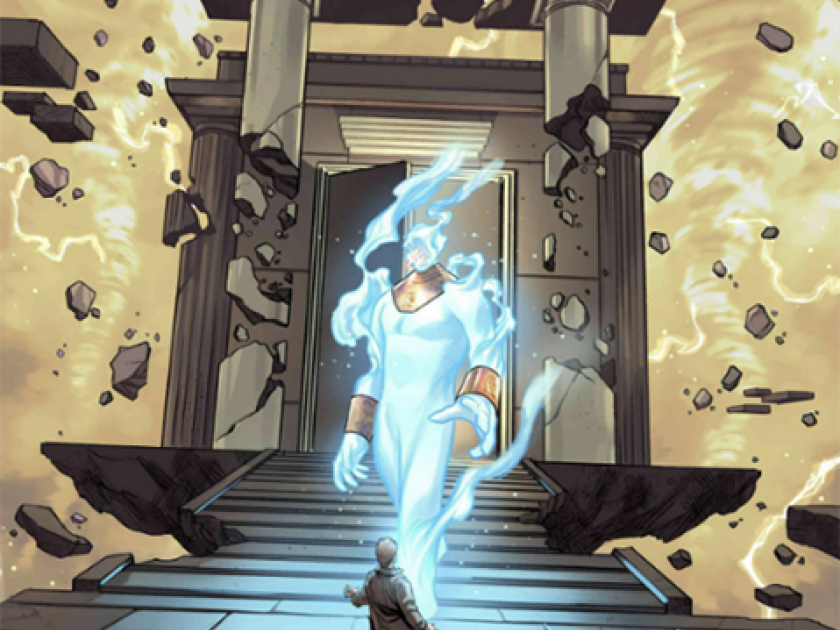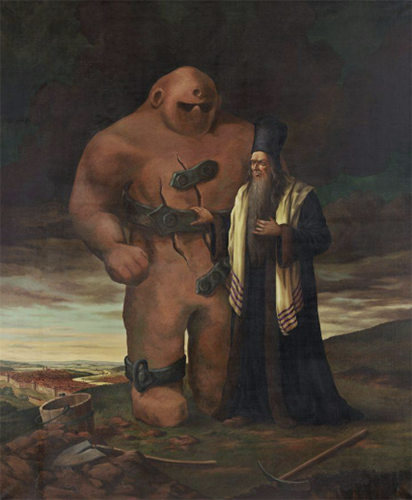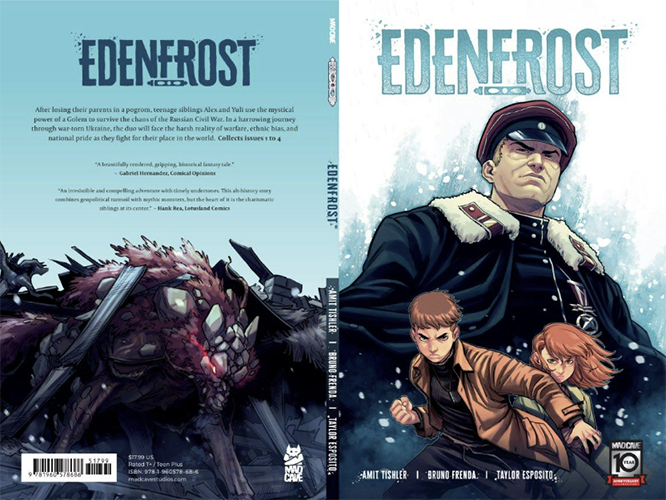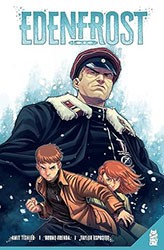
Edenfrost — Alex meets the golem. Art by Bruno Frenda. © Mad Cave Studios, 2024.
“Clay and culture”
The legend of the golem is a timeless part of both Jewish mysticism and literary fiction. Over the years, it has evolved from folktale character to pop-cultural icon, making countless appearances in traditional mediums such as literature, theater, and film, as well as in modern ones like video games, animated shows, and graphic novels. While each adaptation of the story offers its own unique twist on the classic tale, they all contain narratives of warning.
The golem story was created as a reaction to the rise in antisemitism throughout Europe in the late sixteenth century. During this time, Jewish communities grappled with their vulnerability in the face of violent persecution, scapegoating, and discrimination. They were portrayed in propaganda and popular culture as possessing sinister and mystical powers. These cartoonish antisemitic motifs were concurrent with the myth of the golem, a creature traditionally presented as a magical Jewish weapon.

“Le Golem et Rabbi Loew près de Prague” by Miloslav Dvořak, 1951.
In the classic tale, the golem is created by Rabbi Judah Loew ben Bezalel, a famous Talmudic scholar from Prague. He gives life to an artificial being made of clay and tasks it with protecting Jewish communities from pogroms. But while some depict the creature as a loyal protector, others portray it as a destructive force that betrays its creator and then wreaks havoc on the world. Although this negative version of the golem’s origin is compelling in its own right, it’s often viewed as problematic. It can be used to reinforce the antisemitic trope that Jewish people are manipulative figures, capable of unleashing powers beyond their control.
In this fascinating duality between the golem’s role as a benevolent protector for the Jews and a malevolent threat created by them, I found my own version of the creature.

Edenfrost - Graphic Novel Cover. Art by Bruno Frenda. © Mad Cave Studios, 2024.
“Contextual reconstruction”
The notable rise of antisemitism in recent years has made the return of the golem narrative inevitable. After all, it is a historically reliable vehicle for discussing a fraught topic in an entertaining manner. The antisemitic “renaissance” that I witnessed in America between 2016 and 2020 compelled me to use my creative skills, born of more than fifteen years in entertainment, to contribute to the public discourse.
But if every version of this mythological tale was sculpted to reflect its place in history, I needed to ask myself an important question: what kind of golem does the world need, or deserve, in the year 2024?
My grandparents were Eastern European Holocaust survivors; their stories shaped my view of Jewish identity and its place in the world. When I looked at America in the year 2020, I concluded that antisemitism was just a symptom of the degenerative intellectual rot brought about by the mass adoption of identity politics.
Whether social media platforms, economic instability, or distrust of established institutions are to blame, the fragmentation of society in recent years has infected every layer of our public discourse. Yet despite our increased paranoid tribalism, the public’s taste in media has actually evolved. Technology has driven the globalization and diversification of entertainment content and consumption habits. Manga, anime, comics, and video games are now mainstream in both Eastern and Western cultures.
Today’s content consumers are global, and they draw on an entirely new set of media references. This rise in global media literacy has birthed a more educated generation of media consumers that demands greater diversity in the content it consumes. Classic folk narratives are easy to adapt, and in order to appeal to a modern audience’s level of sophistication, the golem story has had to evolve.
“Survival comes first, the tears can wait”
In May 2024, my graphic novel Edenfrost was published in partnership with the independent comic book publisher Mad Cave Studios. A reimagining of the myth of the golem, the book tells the story of Alex and Yulia Lowe, two young Ukrainian Jewish siblings who lose their parents in a pogrom, and use the mystical power of a golem to survive the Russian Civil War.
As implied by their last name, Alex and Yuli are descendants of Rabbi Loew, the golem’s legendary creator. However, in Edenfrost, the golem is not an empty-minded automaton, but an intelligent spirit that is mystically bound to the Lowes’ bloodline. Knowing that the family’s demise will bring about its own drives Edenfrost’s golem to act as both a protector and an agitator. When threatened, it pushes the siblings to choose violence over diplomacy.
Edenfrost’s golem was designed with elements adopted from the popular Japanese mecha genre, which features machines piloted by humans. This golem’s nature is symbiotic; it is completely dependent on its human hosts, appearing only when called upon. When summoned, the golem’s spirit engulfs its summoner in a large suit of armor that is made from surrounding materials and the summoner’s own spirit. So Alex’s protective and humanistic nature produces a golem that is an icy and rocky humanoid guardian, while Yuli’s individualistic and fiery nature is manifest as a titanic, wood- and rock-hewn wolf that struggles to distinguish friend from foe.
“From symbol to omen”
In the macro, Edenfrost is a story that uses the landscape of the Russian Civil War to explore the multilayered topic of identity through the lens of antisemitism. In the micro, it is a story about a twenty-first-century golem with an original, Jewish mysticism – inspired magic system. It’s an epic adventure that draws on contemporary pop-culture trends while still paying homage to its previous iterations. But above all, I believe that Edenfrost is just a cracking good story, full of tension, drama, and action. It introduces readers to a new interpretation of the golem, one sculpted by the very media that inspired me to pursue a career in the arts. But the pride I feel in this work is bittersweet; it cannot be separated from the reason that drove me to create it. Like its previous iterations, Edenfrost’s golem was summoned to warn us of the rise of antisemitism and the growing social divide — which is a painful reminder that this story’s staying power is rooted in a long history of paranoia, cross-generational hatred, and ethnic bias that refuses to go away.

Edenfrost - Graphic Novel. Art by Bruno Frenda. © Mad Cave Studios, 2024.
Amit Tishler is an Israeli-born, LA-based creative director, software designer, animator, and writer. He has brought his diverse talents to shows, games, and immersive experiences for entertainment brands such as Cartoon Network, Warner Brothers, HBO, Comedy Central, Nickelodeon, and more. A prolific writer and content creator, Amit is developing multiple, original graphic novels and comic book titles with publishers such as Mad Cave Studios and Humanoids Publishing, as well as a slate of original TV shows for networks, studios, and streamers worldwide.



